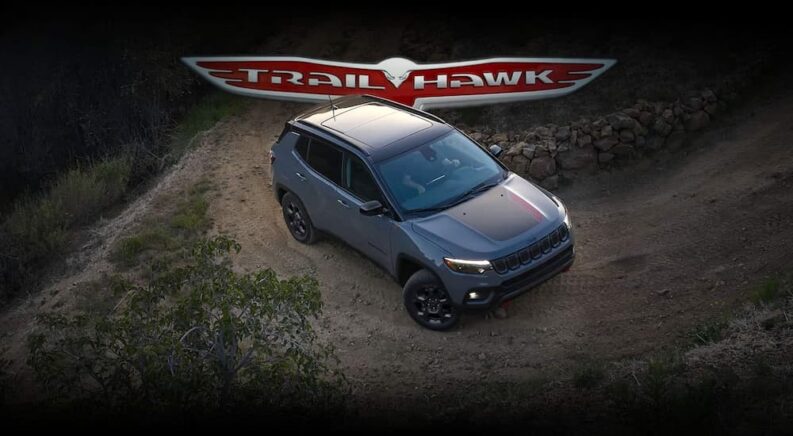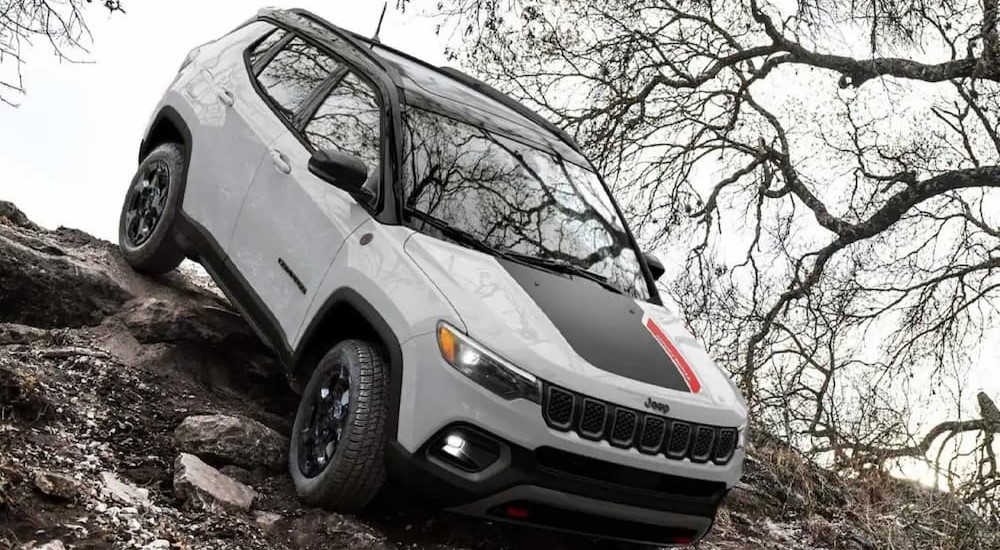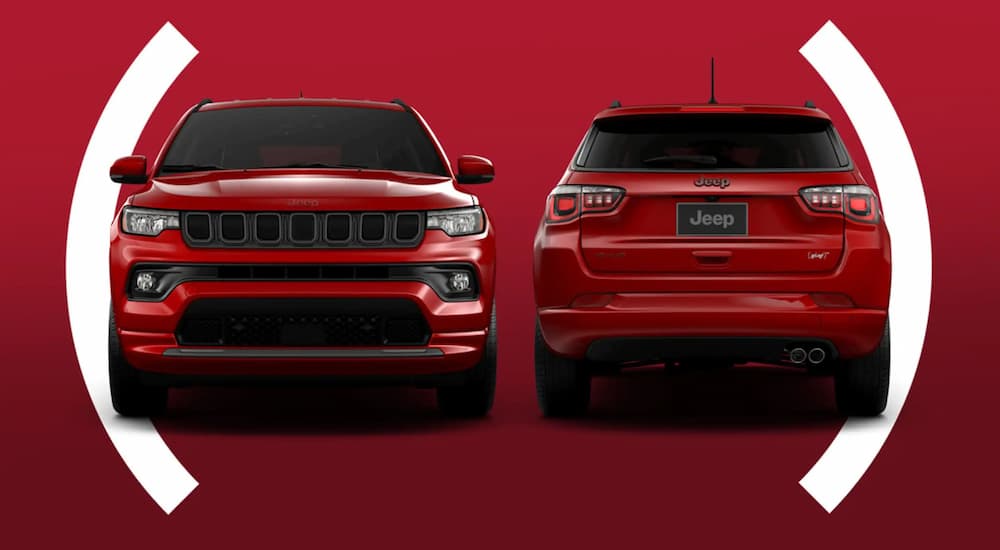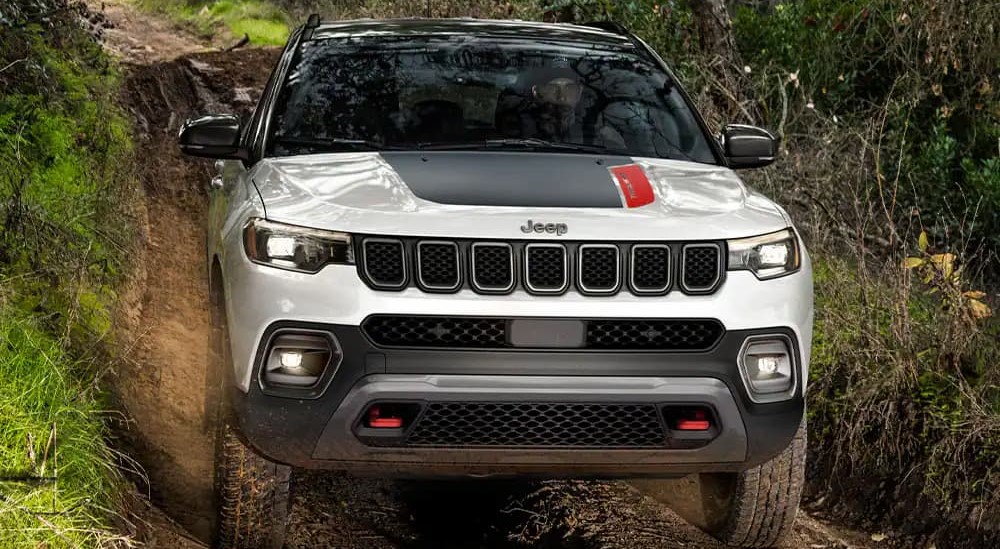There’s no denying that Jeep is essentially synonymous with “adventure,” or at least the adventurous spirit of a vehicle designed to take you just about anywhere. That being said, not all Jeep vehicles are necessarily designed for leaving civilization behind and taking you on the road less traveled. There are plenty of models you might find at a new or used Jeep dealer that are great for getting around town but not necessarily ideal for going out and hitting the trail. For every Jeep Wrangler or Gladiator, there’s a Cherokee or Compass that’s really meant to be a mall crawler more than anything else.
That being said, even amongst these models destined to stick to the road, there are still exceptions to be found—that’s what the Jeep Trail Rated badge is all about. The Jeep Compass is a compact crossover SUV that spends most of its life in daily commutes, running errands, and taking kids to and from school. And yet, within the selection of Compass models out there, some are worthy of having a place alongside the most adventurous Wrangler models. The trick to finding these elusive off-road Compass options is to look for one word: Trailhawk; let’s take a look at what the Trailhawk brings with it and how it transforms the Compass.
Background on the Jeep Compass and Trailhawk
When the Jeep Compass first hit the road for the 2007 model year, it was clear that it was designed for city driving and folks interested in a Jeep without committing to an off-road model like the Wrangler. In fact, for its first generation, no Compass model even had the Trail Rated badge, and there wasn’t a dedicated off-road trim like there is now. This makes a fair amount of sense: Jeep already had the off-road market covered with vehicles like the Wrangler, so the Compass was meant to represent something new. Of course, as time went on, they realized many of their drivers liked the look and feel of the Compass and wanted impressive off-road capability.
The first-generation Jeep Compass received a mid-cycle update and facelift for the 2011 model year that included a number of upgrades. Alongside updated suspension, refreshed interior, and more packages becoming available, the 2011 Compass also gained the Trail Rated badge on certain models. This doesn’t mean that every Compass suddenly became the perfect off-road machine; most Compass models remained better for exploring the mall rather than the trail, but it created a viable option. Although different trim levels were available for the Compass throughout its first generation, it still lacked an off-road focused model that was perfect for the trail—the available Freedom Drive II Off-Road package was the best choice for that role.
This changed with the 2017 model year when Jeep launched the second generation of the Compass, which includes what has become one of the most impressive off-road crossover options on the market. That’s because the second-generation Compass has an available Trailhawk trim that’s designed to be incredibly capable in a wide range of conditions. It’s beyond simply meeting the requirements for the Trail Rated badge, and in many ways, it transforms what the Compass has to offer. To see just what I mean, first, we’ll look at the standard features of the current 2023 Jeep Compass, then at what the Trailhawk adds.
The Modern Jeep Compass
The starting trim for the 2023 Compass is the Sport, which includes a standard 2.0L I-4 engine that delivers 200 hp and 221 lb-ft of torque. Every model, including the Sport, comes with four-wheel drive (4×4), which is great for dealing with rough weather or dirt roads, and 2,000 lbs of towing capacity is standard. An eight-speed automatic transmission makes driving the Compass responsive and enjoyable, plus the Sport trim comes with a standard suspension and 17-inch wheels wrapped in All-Season tires.
On the outside, the Compass Sport features standard power-adjusting mirrors perfect for making changes while getting around town and basic lighting. Standard features also include variable intermittent windshield wipers, Compass badging, and black door handles with a body-color roof. Inside, the standard Compass includes cloth low-back bucket seats, a six-way adjustable driver’s seat, and basic features with a short list of options for upgrades available. A 10.1-inch infotainment system is standard with a six-speaker sound system, but if you want much more than that, you need to look at a higher trim.
What a Difference the Trailhawk Makes
Now that we have a good sense of the Jeep Compass’s standard features let’s look at what the Trailhawk trim brings to the party. In terms of performance, it has many of the same features as the standard model, including the same engine, transmission, and Selec-Terrain transfer case with standard 4×4 performance. Where other Compass models have a basic suspension, the Trailhawk features an Off-Road Suspension designed to handle the bumps and uneven terrain you’ll encounter on the trail. The Trailhawk also has two front red tow hooks, just in case, plus skid plates to protect the front suspension, fuel tank, transmission, and transfer case—none of these are available for the standard Compass Sport.
Differences on the outside aren’t all immediately noticeable, but once you take a good look at different Compass models, they become evident. For example, the side mirrors on the Trailhawk have supplemental signals built into them to help ensure other drivers can see when you’re turning, and the Trailhawk comes with body-color door handles and a black roof. This difference in roofs is particularly noteworthy because the Trailhawk is primarily available in two-tone exterior colors like Sting-Gray with Black or Redline with Black, creating a striking appearance that you won’t find with standard Sport models.
The Trailhawk comes with 17-inch wheels, which are not as wide as the ones on the Sport, wrapped in All-Season On/Off Road tires. Inside, the Trailhawk features a Black and Ruby Red interior color scheme, including premium cloth bucket seats with leather-trim; exclusive Trailhawk premium leather-trimmed seats are also available. Available options are far more diverse with the Trailhawk, including eight-way power-adjustable driver and front-passenger seats, heated and ventilated front seats, Navigation for the infotainment system, and a premium Alpine speaker system; none of these are offered on the Sport trim. You can also get a dual-pane panoramic sunroof that you won’t find on the Sport, while dual-zone automatic temperature control is standard on the Trailhawk.
Built for Adventure
To be completely fair, the Trailhawk trim doesn’t turn the Compass into a Jeep Wrangler, but it does transform it into a Trail Rated beauty that has improved traction, water fording, articulation, and ground clearance designed for going off-road. I love the Wrangler, but it’s not for everyone; drivers looking for a clean and conventional crossover SUV that can tackle many trails will find the Compass Trailhawk the perfect choice. Offering these kinds of options to drivers is perfect for Jeep since their lineup almost exclusively consists of SUVs and crossover models, so it’s important that there’s a fair amount of freedom and diversity among them.
Since it was first introduced, the Trailhawk has elevated Compass models to make them perfect for going off-road, beyond their stereotypical role as family-friendly mall crawlers. The Wrangler is still there for people who need incredible trail performance—particularly with the Rubicon trim—but the Compass Trailhawk is a worthy adventurer ready to leave civilization behind.







